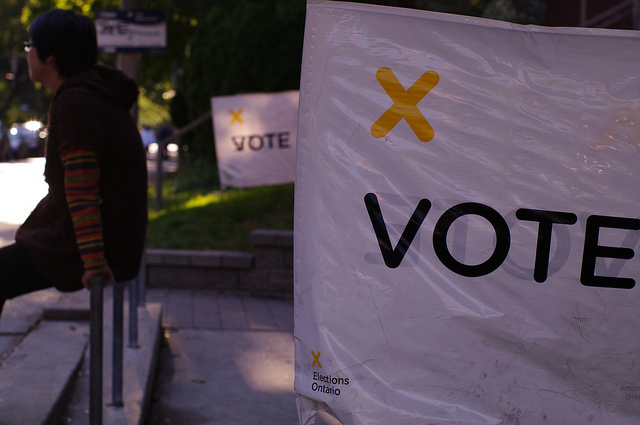Please support our coverage of democratic movements and become a monthly supporter of rabble.ca.
In April, the Ontario Liberal government appointed Bilderberg Steering Committee member Ed Clark (President/CEO of TD Bank Group) to lead a five-member council that will consider options to “optimize the full value” of provincial assets such as Ontario Power Generation (OPG) and Hydro One — potentially privatizing key electricity transmission and distribution assets.
That would be an astonishing move — outdoing even the old Mike Harris vision — and should be a primary focus of the Ontario election on June 12.
Having already handed power-production over to private-sector independent power producers (IPPs) and guaranteeing them outrageously high feed-in tariffs, Ontario seems to be following in the disastrous path of Alberta. There, $16 billion taxpayer dollars have been poured into building transmission infrastructure owned by the private sector, primarily Atco and SNC Lavalin’s AltaLink. To the shock of many, in May 2014 Warren Buffett’s Berkshire Hathaway Energy announced a $3.2 billion deal to buy AltaLink, which serves more than four-fifths of the province.
Financial analyst Erik Andersen told me by email that the takeover bid is “not a surprise” to the financial industry because “all P3 [public-private partnership] and IPP contracts are transferable” and “ownership moves up the food chain.”
Back to the Future
By 2012, TransCanada Corp. had become the biggest IPP in Ontario. Bruce Power — one of whose owners is TransCanada Corp. — is reportedly now eyeing the purchase of OPG, or parts of it. Privatizing Ontario’s electricity transmission sector would also facilitate energy-export corridors, which TransCanada is involved in planning.
To that end, unions like OPSEU are decidedly in the way, with reports like “Epic Fail: A Short History of Privatization in Ontario.” A full-page newspaper ad by OPSEU on May 31 warned that both Ontario premier Kathleen Wynne and PC Leader Tim Hudak agree on privatization of Ontario assets, which “moves wealth to the top.”
But the Bilderberg elite, at the top of the food chain, have learned how to deal with unions.
At the May 2012 Bilderberg meeting, another guest — besides Alison Redford — was Mitch Daniels (at the time, Governor of Indiana), who made a panel presentation at the secret conclave. Just months before, in February 2012, Indiana had become the first industrial Midwest state to adopt anti-union legislation under so-called “right-to-work” laws. Mitch Daniels likely described for the “world decision makers” how the assault on Indiana unions was accomplished.
With the Harper government ridding itself of more than 25,000 unionized public servants, by 2013 Redford also supported the passing of draconian anti-union legislation provincially. A December 2013 Canadian Press article noted, “Critics say 2013 revealed Redford as an eel-slippery manipulator launched into power by a progressive coalition of liberals, unionists and students whom she then abandoned for a new role as business shill and oilsands-industry glove puppet.”
For that new role, the Bilderberg meeting appears to have been pivotal.
Getting to Tidewater
In Spring 2012, TransCanada Corp.’s CEO Russ Girling told PostMedia News (May 1, 2012) that the company “is looking at switching part of its existing [natural gas] mainline to bitumen, enabling us to transport up to 800,000 barrels of oilsands crude a day to eastern refineries.” TransCanada’s mainline, with multiple parallel pipes, stretches from Alberta to Ontario, with a new section to be built from the Ontario-Quebec border to New Brunswick.
Mark Carney, Governor of the Bank of Canada at the time, had already told Canadian Press (April 8, 2012) that he was in favour of “building actual energy infrastructure” — not just reversing a pipeline like Enbridge — to get Western oil and gas to the East Coast. And Frank McKenna had since 2011 been promoting a tar sands pipeline to East Coast tidewater.
As we saw in Part 2, in attendance at that May 2012 Bilderberg conclave were: Alberta Premier Alison Redford, two early proponents of TransCanada’s west-to-east tar sands pipeline (Mark Carney and Frank McKenna), and PMO Chief of Staff Nigel Wright, who had been lobbied by Bruce Carson of the Energy Policy Institute of Canada (EPIC), advocating energy-export corridors and a national energy plan written by corporate members.
Other Bilderberg attendees included top executives from Royal Dutch Shell (CEO Peter Voser and Chair Jorma Ollila) and BP (CEO Robert Dudley). Both companies are tar sands producers that also have heavy-oil refineries in the U.S. Gulf Coast.
Given the timing and the participants, it’s likely that TransCanada’s west-to-east pipeline proposal was tacitly approved at the Bilderberg meeting.
Indeed, just weeks later, the Canadian Council of Chief Executives released Framing An Energy Strategy for Canada, which advocated “strengthening continental energy relationships” and stated, “It is encouraging to see Canadian companies [Enbridge and TransCanada Corp.] exploring the potential to bring more Western Canadian crude to Eastern Canadian markets.”
Simultaneously, the Harper government’s 2012 omnibus budget bills infringed on First Nations’ treaty rights and gutted environmental protection, the Fisheries Act and the Navigable Waters Act at the request of industry — leaving millions of rivers and lakes without federal protection.
For the Bilderberg elite, things were falling into place nicely.
Read Part one and Part two of Joyce Nelson’s feature The Rockefeller files.
Joyce Nelson is an award-winning freelance writer/researcher and the author of five books.
Photo: flickr/knehcsg



